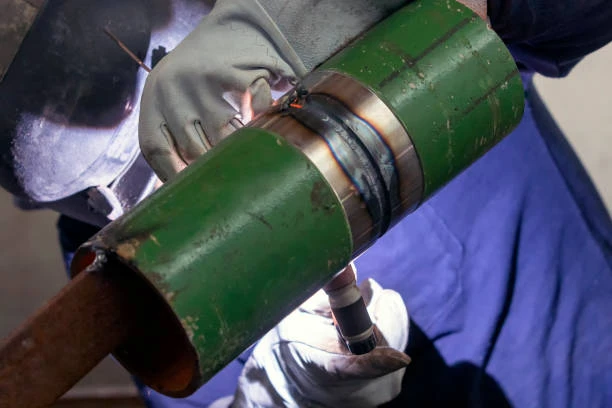Introduction
In the world of plumbing and construction, the integrity of pipe joints is crucial. Traditional welded joints can present various issues, including corrosion, durability concerns, and potential leaks. Enter the innovative weldless pipe joint system. This groundbreaking approach offers a solution that not only enhances the longevity of piping systems but also addresses common worries associated with traditional welding methods. In this article, we will explore the benefits of weldless pipe systems and how they can revolutionize plumbing applications.
What is a Weldless Pipe Joint System?
A weldless pipe joint system refers to a method of connecting pipes without the need for welding. Instead, it utilizes mechanical fittings or other advanced technologies to create secure connections. This system is designed to withstand high pressures and environmental challenges, making it a reliable choice for various applications.

The Problem with Traditional Welding
Corrosion
Welded joints are often susceptible to corrosion, especially in environments with high moisture or chemical exposure. When welding creates heat, it can alter the metal’s properties, leading to weakened areas that may corrode over time.
Durability Concerns
Welded joints can become brittle, especially if exposed to extreme temperatures or repetitive stress. This brittleness can result in joint failure, leading to costly repairs and downtime.
Leakage Issues
One of the most significant concerns with traditional welding is the potential for leaks. If a weld is not executed perfectly, it can create weak spots where water or gas can escape, leading to significant safety hazards and environmental concerns.
Advantages of Weldless Pipe Systems
1. Enhanced Durability
Weldless pipe systems are designed with durability in mind. They utilize robust materials and innovative connections that are less prone to failure compared to traditional welded joints. This durability translates into longer-lasting installations, reducing the need for frequent repairs.
2. Corrosion Resistance
Many weldless pipe systems are made from corrosion-resistant materials such as stainless steel or specialized plastics. These materials withstand harsh environments, making them ideal for both residential and industrial applications.
3. Leak-Free Connections
The mechanical fittings used in weldless pipe systems are engineered to create secure, leak-free connections. This reliability is crucial for maintaining the integrity of water and gas systems, ensuring safety and efficiency.
4. Faster Installation
Without the need for welding, installation times can be significantly reduced. Weldless systems can be assembled quickly using standard tools, allowing for faster project completion and reduced labor costs.
5. Flexibility and Adaptability
Weldless pipe systems are versatile and can be easily adapted for various applications. Whether for plumbing, HVAC, or industrial uses, these systems can accommodate different pipe sizes and configurations with ease.
Applications of Weldless Pipe Systems
1. Plumbing
In residential and commercial plumbing, weldless pipes provide secure connections that prevent leaks and enhance durability. They are especially useful in areas with high humidity or exposure to chemicals.
2. HVAC Systems
Heating, ventilation, and air conditioning (HVAC) systems often require reliable and efficient piping solutions. Weldless pipe systems offer the necessary durability and flexibility to handle varying temperatures and pressures.
3. Industrial Uses
In industrial settings, where pipes are subject to harsh conditions, weldless systems are invaluable. Their resistance to corrosion and wear makes them ideal for transporting chemicals, water, and gases safely.
Choosing the Right Weldless Pipe System
When selecting a weldless pipes system, consider the following factors:
- Material: Ensure that the materials used are suitable for your specific application. Corrosion-resistant options are essential for longevity.
- Compatibility: Check that the system is compatible with existing plumbing or piping systems to avoid costly modifications.
- Manufacturer Reputation: Choose systems from reputable manufacturers known for quality and reliability.
- Cost vs. Value: While weldless systems may have a higher initial cost, consider the long-term savings associated with durability and reduced maintenance needs.
Conclusion
The innovative weldless pipe joint system presents a modern solution to the age-old problems of corrosion, durability, and leakage in plumbing and industrial applications. By eliminating the need for welding, these systems offer enhanced reliability, faster installation, and significant cost savings over time. If you’re considering upgrading your piping systems, the weldless approach could be the answer you’ve been looking for.
FAQs
- What is a weldless pipe system?
- A weldless pipe system is a method of connecting pipes without welding, using mechanical fittings or other technologies to create secure connections.
- What are the advantages of using weldless pipes?
- Advantages include enhanced durability, corrosion resistance, leak-free connections, faster installation, and adaptability for various applications.
- Where can weldless pipe systems be used?
- Weldless pipe systems are suitable for plumbing, HVAC, and industrial applications, particularly in environments prone to corrosion or harsh conditions.
- Are weldless pipes more expensive than traditional welded pipes?
- While the initial cost may be higher, weldless systems often provide long-term savings due to reduced maintenance and increased durability.
- How do I choose the right weldless pipe system?
- Consider factors such as material suitability, compatibility with existing systems, manufacturer reputation, and overall cost versus value.

















